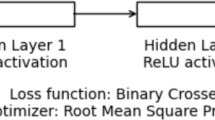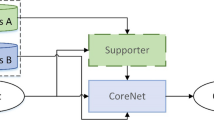Abstract
Due to the complexity and extensive application of wireless systems, fading channel modeling is of great importance for designing a mobile network, especially for high speed environments. High mobility challenges the speed of channel estimation and model optimization. In this study, we propose a single-hidden layer feedforward neural network (SLFN) approach to modelling fading channels, including large-scale attenuation and small-scale variation. The arrangements of SLFN in path loss (PL) prediction and fading channel estimation are provided, and the information in both of them is trained with extreme learning machine (ELM) algorithm and a faster back-propagation (BP) algorithm called Levenberg-Marquardt algorithm. Computer simulations show that our proposed SLFN estimators could obtain PL prediction and the instantaneous channel transfer function of sufficient accuracy. Furthermore, compared with BP algorithm, the ability of ELM to provide millisecond-level learning makes it very suitable for fading channel modelling in high speed scenarios.











Similar content being viewed by others
Explore related subjects
Discover the latest articles, news and stories from top researchers in related subjects.References
Beek, J. J., Edfors, O., Sandell, M., Wilson, S. K., & Borjesson, P. (1995). On channel estimation in OFDM systems. In Proceedings of IEEE Vehicular Technology Conference, 2, 815C819. New York: IEEE.
Bogdan, M., Wilamowski, B., & Yu, H. (2010). Improved computation for Levenberg-Marquardt training. IEEE Transactions on Neural Networks, 21, 930–937.
Calle-Sanchez, J., Molina-Garcia, M., Alonso, J., & Fernandez-Duran, A. (2013). Long term evolution in high speed railway environments: Feasibility and challenges. Bell Labs Technical Journal, 18, 237–253.
Cao, J., & Lin, Z. (2015). Extreme learning machines on high dimensional and large data applications: A survey. Mathematical Problems in Engineering, 2015. doi:10.1155/2015/103796.
Cao, J., Chen, T., & Fan, J. (2015). Landmark recognition with compact BoW histogram and ensemble ELM. Multimedia Tools and Applications. doi:10.1007/s11042-014-2424-1.
Cao, J., & Lin, Z. (2014). Bayesian signal detection with compressed measurements. Information Sciences, 289, 241–253.
Cao, J., Lin, Z., Huang, G., & Liu, N. (2012). Voting based extreme learning machine. Information Sciences, 185, 66–77.
Cao, J., & Xiong, L. (2014). Protein sequence classification with improved extreme learning machine algorithms. BioMed Research International, 2014, 103054.
Cao, J., Zhao, Y., Lai, X., Ong, M., Yin, C., Koh, Z., et al. (2015). Landmark recognition with sparse representation classification and extreme learning machine. Journal of The Franklin Institute, 352, 4528–4545.
Chang, D., & Wu, D. (2014). Despread-ahead cyclic-prefix code division multiple access receiver with compressive sensing channel impulse response estimation. IET Communications, 8, 1425–1435.
Cheng, C., Huang, Y., Chen, H., & Yao, T. (2015). Neural network-based estimation for OFDM channels. In Proceeding of International Conference on Advanced Information Networking and Applications, 29, pp. 600–604, New York: IEEE.
Chen, J. T., Paulraj, A., & Reddy, U. (1999). Multichannel maximum-likelihood sequence estimation (MLSE) equalizer for GSM using a parametric channel model. IEEE Transactions on Communications, 47, 53–63.
Durgin, G. D. (2009). The practical behavior of various edge-diffraction formulas. IEEE Antennas and Propagatation Magazine, 51, 24–35.
Erceg, V., Greenstein, L. J., Tjandra, S. Y., Parkoff, S. R., Gupta, A., & Kulic, B. (1999). An empirically based path loss model for wireless channels in suburban environments. IEEE Journal on Selected Areas in Communications, 17, 1205–1211.
Fang, Y. (2010). Joint source-channel estimation using accumulated LDPC syndrome. IEEE Communications Letters, 14, 1044–1046.
Friis, H. T. (1946). A note on a simple transmission formula. Proceedings of the IRE, 34, 254–256.
Golestan, K., Sattar, F., Karray, F., Kamel, M., & Seifzadeh, S. (2015). Localization in vehicular ad hoc networks using data fusion and V2V communication. Computer Communications, In Press.
Herring, K. T., Holloway, J. W., Staelin, D. H., & Bliss, D. W. (2012). Pathloss characteristics of urban wireless channels. IEEE Transactions on Antennas and Propagation, 58, 171–177.
Hills, A. (2001). Large-scale wireless LAN design. IEEE Communications Magazine, 39, 98–107.
ITU-R. (2002). Terrestrial land mobile radiowave propagation in the VHF/UHF bands. Geneva, Switzerland: ITU Publications.
Kastell, K. (2011). Challenges and improvements in communication with vehicles and devices moving with high-speed. In Proceeding of International Conference Transparent Optical Networks, pp. 26–30. New York: IEEE.
Kim, W., & Hansen, J. H. (2015). Advanced parallel combined Gaussian mixture model based feature compensation integrated with iterative channel estimation. Speech Communication, 73, 81–93.
Larsen, M. D., Swindlehurst, A., & Svantesson, F. (2009). Performance bounds for MIMO-OFDM channel estimation. IEEE Transactions on signal processing, 57, 1901–1916.
Lee, W. C. (1985). Estimate of local average power of a mobile radio signal. IEEE Transations on Vehicular Technology, 34, 22–27.
Li, S., Le-Ngoc, L., & Kwon, S. C. (2010). Turbo joint channel estimation, synchronization, and decoding for coded OFDM systems. International Journal of Electronics and Communications, 64, 663–670.
Liu, J., Jin, X., & Dong, F. (2012). Wireless fading analysis in communication system in high-speed Train. Journal of Zhejiang University, 46, 1580–1584.
Marchant, B. P., & Lark, R. M. (2007). Optimized sample schemes for geostatistical surveys. Mathematical Geology, 39, 113–134.
Mielczarek, B., & Svensson, A. (2005). Modeling fading channel-estimation errors in pilot-symbol-assisted systems with application to Turbo codes. IEEE Transactions on Communications, 53, 1822–1832.
Panda, S., Mohapatra, P. K., & Panigrahi, S. P. (2015). A new training scheme for neural networks and application in non-linear channel equalization. Applied Soft Computing, 27, 47–52.
Phillips, C., Sicker, D., & Grunwald, D. (2013). A survey of wireless path loss prediction and coverage mapping methods. IEEE Communications Surveys and Tutorials, 15, 255–270.
Pun, M. O., Molisch, A. F., Orlik, P., & Okazaki, A. (2011). Super-resolution blind channel modeling. In Proceedings of IEEE International Conference on Communications, 47, 1–5. New York: IEEE.
Qing, H., & Gang, Y. (2014). Parametric channel modeling based OFDM channel estimation. The Journal of China Universities of Posts and Telecommunications, 21, 1–8.
Rappaport, T. S. (2001). Wireless communications: Principles and practice. New Jersey: Prentice-Hall.
Robinson, J., Swaminathan, R., & Knightly, E. W. (2008). Assessment of urban-scale wirelesss networks with a small number of measurements. Proceedings of ACM Mobicom, 14, 187–198.
Sarma, K. K., & Mitra, A. (2013). MIMO channel modelling using multi-layer perceptron with finite impulse response and infinite impulse response synapses. IET Communications, 7, 1540–1549.
Seidel, S., & Rappaport, T. S. (1991). Path loss prediction in multifloored buildings at 914 MHz. Electronics Letters, 27, 1384–1387.
Seyman, M., & Taspinar, N. (2013). Channel estimation based on neural network in space time block coded MIMOCOFDM system. Digital Signal Processing, 23, 275–280.
Shu, X., Zhu, L., Zhao, H. & Tang, T. (2014). Design and performance tests in an integrated TD-LTE based train ground communication system. In Proceedings of IEEE International Conference on Intelligent Transportation Systems. New York: IEEE, pp. 747–750.
Simsir, S., & Taspinar, N. (2015). Channel estimation using radial basis function neural network in OFDM-IDMA system. Wireless Personal Communications, 82, 1–11.
Sotiroudis, S. P., & Siakavara, K. (2015). Mobile radio propagation path loss prediction using artificial neural networks with optimal input information for urban environments. International Journal of Electronics and Communications, 69, 1453–1463.
Tariq, S. (1991). Back propagation with expected source values. Neural Networks, 4, 615–618.
Taspinar, N., & Cicek, M. (2013). Neural network based receiver for multiuser detection in MC-CDMA systems. Wireless Personal Communications, 68, 463–472.
Valenti, M. C., & Woerner, B. D. (2001). Iterative channel estimation and decoding of pilot symbol aAssisted Turbo codes over flat-fading channels. IEEE Journal on Selected Areas in Communications, 19, 1697–1705.
Vieira, M. A., Taylor, M. E., Tandon, P., & Jain, M. (2013). Mitigating multi-path fading in a mobile mesh network. Ad Hoc Networks, 11, 1510–1521.
Yang, B., Letaief, K., Cheng, R. S., & Cao, Z. (2001). Channel estimation for OFDM transmission in multipath fading channels based on parametric channel modeling. IEEE Transactions on Communications, 49, 467–479.
Zhou, Y., & Ai, B. (2014). Handover schemes and algorithms of high-speed mobile environment: A survey. Computer Communications, 47, 1–15.
Acknowledgments
This work was supported by the Natural Science Foundation of Zhejiang province (China under Grants LY15F030017, LY12F03017 and LQ13G010005), National Natural Science Foundation of China (China under Grants 61403224).
Author information
Authors and Affiliations
Corresponding author
Rights and permissions
About this article
Cite this article
Liu, J., Jin, X., Dong, F. et al. Fading channel modelling using single-hidden layer feedforward neural networks. Multidim Syst Sign Process 28, 885–903 (2017). https://doi.org/10.1007/s11045-015-0380-1
Received:
Revised:
Accepted:
Published:
Issue Date:
DOI: https://doi.org/10.1007/s11045-015-0380-1




